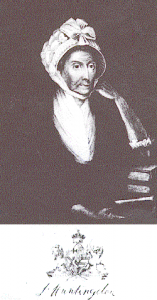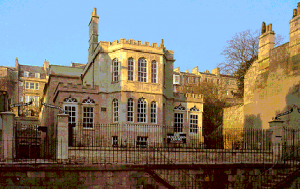Religion in Bath
Lady Huntingdon in Bath

- Lady Huntingdon
- [click on the picture to enlarge it]

- Huntingdon’s Chapel
- [click on the picture to enlarge it]
Selina Hastings, Countess of Huntingdon (1707-1791)
She came to Bath in 1739 with her husband, who was a friend of Ralph Allen.
Widowed in 1746, she returned to Bath in 1747, and stayed there almost annually till her death.
She devoted her energy to the furthering of the Gospel in her circle of acquaintances in Bath. In 1765, she built a chapel in the “Gothick” style (nowadays the Museum of the Building of Bath) for Methodist worship.
Her role was similar to that of Lady Glenorchy in Edinburgh.
Presbyterianism in Bath
A congregation of English presbyterians first gathered in a meeting house in Frog Lane which opened in 1692, i.e. only three years after the passing of the ’Toleration Act’.
The register of baptisms held between 1719 and 1756, when Dr. Bennet Stevenson was minister there, reveals that the congregation included many farmers, particularly from the neighbouring villages of Englishcombe and Batheaston - an interesting insight into the socio-economic status of Dissenters.
Like many English presbyterians, the congregation shifted to Unitarianism in the latter half of the century. Although Unitarian worship remained illegal until the passing of the Trinity Act (1796), the titlepage of the ordination service for the minister newly appointed in 1789, David Jardine, refers to the meeting house as a Unitarian chapel.
Among letters preserved in the archives is the copy of a letter of sympathy to Dr. Priestley, presumably when his house and church had been destroyed by a mob, signed by many Dissenters from Bristol and Bath. This provides evidence, both of the radicalization of late eighteenth-century non-conformists, and of the sense of the unity of the ’dissenting interest’.
Roman Catholics in Bath
It is difficult to know the exact proportion of Catholic residents in eighteenth-century Bath, but in those parishes where population records are available, the number of adult “papists”, as they were then known, represented between 8 and 10 per cent of the number of ratepayers - a significantly higher proportion than in the rest of the country.
Almost all the Catholics in the city were servants or skilled tradesmen - a reflection on the leading trade of the city. Curiously enough, there were no resident Catholic gentry, although many Catholic gentlemen visited the city and brought with them their domestic servants. They lodged at the Bell Tree House (at the corner of Binbury Land and Beau Street), which had a chapel with rich vestments and decorations on the second floor. As it had become too small, a new chapel was built in 1771, which suggests that the congregation had grown in size, and also that on the whole, like most of their English counterparts, Catholics enjoyed a kind of de facto toleration in Bath, except in times of crisis.
Thus, known or reputed “papists” were victimised in Bath at the same time as their coreligionists were persecuted by the Gordon Riots (1780) in London.
The Gordon Riots in Bath (1780)
I am the unfortunate Roman Catholic clergyman, who was hunted from place to place and pursued through several streets the evening of the Bath riot: it was with great difficulty I escaped from falling a victim to the fury of the mob. Being here the public minister for people of our persuasion I am well known and was openly attacked in the street that evening by one Butler, who … was then servant to Mr. Baldwin, a gentleman living in this town. After pursuing me at the head of the mob he led them to my house and chapel, both which, together with all the furniture and books, were entirely destroyed. The unhappy man was afterwards tried and hanged on the spot, though from motives of delicacy I did not give evidence at his trial.
The Belltree, which is threatened to be first set on fire, is the house I now live in, in the upper part of which there is a long room set aside for divine worship…
I beg leave to observe that all the Catholics here, most of whom are gentlemen of family and property, chearfully [sic] took the late oaths of allegiance tendered to them by his Majesty and therefore, both on that account and for their constant peaceable behavior, flatter themselves they are entitled to his Majesty’s protection.WILLIAMS, Post-Reformation Catholicism, I, 198-9, quoted in Voices of Bath 137.

